| |
STORIES, BOOKS & MEDIA

The majority of the following books are from the library of Chon Tri. Many of the summaries and in his own words. If you wish to purchase the book, click on the cover image and you will be linked to Amazon.com.
| Select a Category » |
[
Foundation
]
[
Practice
]
[
Sutra & Sastra
]
[
Koans
]
[
Works
]
[
History & References
]
[
Essays & Studies
]
[
Others
]
» Buy this book
» Recommend a Book
|
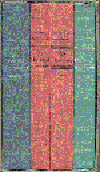
|
121. HINDU: THE UPANISHADS (4 VOLUME SET)
by Swami Nikhilananda (translator)
Publisher: Ramakrishna-Vivekananda Center (ISBN #: 0911206140, Hardcover, 1507 pages, June 1987)
» Submit a review
Summary
Volume I: Cryptic..but deep., September 11, 2001
Reviewer: Steve Uhlig (Louvain-la-Neuve Belgium)
This book provides an excellent treatment of what the vedantas call "Brahman". This latter term indeed represents the concept of "emptiness" or "Self" in the buddhist literature. This first volume of a series of four presents the general philosophy of the Upanishads by explaining the terms used throughout the four volumes of the series. The meaning of the text is by no means easy to grasp and the intent is not there.
Volume II: the Ultimate Reality, September 20, 2001
Reviewer: Steve Uhlig (Louvain-la-Neuve Belgium)
..., this second volume goes straight into the subject of the Ultimate Reality or "Atman", "Brahman", "emptiness of phenomena" for buddhists). While i consider the first volume not to be an easy read, this volume goes beyond any such treatment of the "Absolute" i've seen so far. Beware of the various contentions and objections between the dualists and non-dualists schools that are mentionned in the text, because it could easily mislead the reader about the point to be explained....
Volume III: "Rituals and sacrifices", September 28, 2001
Reviewer: Steve Uhlig (Louvain-la-Neuve Belgium)
This third volume deals with the relative truth provided by rituals and sacrifices, which objective is to bring conscience about their "unefficiency" at an absolute point of view for bringing knowledge of "Brahman" (the ultimate reality). These rituals and sacrifices are means for realizing it through superimposition, i.e. adding some false semantics over what is to be understood and then invalidating it by showing its inconsistency with what is to be understood....
Volume IV: where the Buddhists Teachings come from..., September 29, 2001.
Reviewer: Steve Uhlig (Louvain-la-Neuve Belgium)
This volume contains most of the stories told in the Buddhist Teachings. Many examples seen in this volume can also be found in the Teachings of the Buddha Gotama. Brahman is explained through symbols like the "elements" (air, fire,...), objects for meditation, short stories that also appear in the Buddhist literature. However, these examples and stories are explained in a rather crude manner in this volume, compared to what can be found in the Buddhist Teachings. The advantage being that they are presented in a condensed manner here, with the most profound ones in this single volume...
The Authoritative Translation, October 3, 2001
Reviewer: James Foard (Medford, Oregon)
To have a work of this philosophic profoundness translated by someone who was himself steeped in the very same tradition as the work that he is translating is a privelege.
Swami Nikhilananda was a genuine Hindu holy man who was also a scholar and he brings to this translation rare insights that can only be found from the actual experience of what he is writing of.
Be careful of premature comparisons between the Upanishads and the teachings of Buddhism: While there are similarities between both traditions, they are each distinct and have their own value and integrity as religious systems and both make a decided contribution to the wisdom of the religions of the east.
|
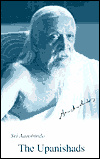
|
122. HINDU: THE UPANISHADS, 1ST US EDITION
by Sri Aurobindo
Publisher: Lotus Press (WI) (ISBN #: 0914955233, Paperback: 466 pages, June 1998)
» Submit a review
Summary
Editorial Reviews
Book Description
The Upanishads is a collection of Sri Aurobindo's final translations of and commentaries on every Upanishad or other Vedantic text he worked on. Upanishads are the ancient treatises on spiritual truths as envisioned by the seers, sages and rishis of the civilization of India. Index.
First Sentence:
"The Upanishads are the supreme work of the Indian mind, and that it should be so, that the highest self- expression of its genius, its sublimest poetry, its greatest creation of the thought and word should be not a literary or poetical masterpiece of the ordinary kind, but a large flood of spiritual revelation of this direct and profound character, is a significant fact, evidence of a unique mentality and unusual turn of spirit..."
|
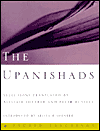
|
123. HINDU: THE UPANISHADS: SELECTIONS
by Alistair Shearer & Peter Russell (translators)
Publisher: Crown Publishing Group (ISBN #: 0609611070, Hardcover, 172 pp, June 2003)
» Submit a review
Summary
From the Publisher
The Upanishads are the oldest and clearest expression of the perennial philosophy that is the inner core of all the great religions. Passed down by word of mouth for five thousand years, they teach of an absolute and unified field of intelligence that underlies and permeates all creation. This divine ground is our own nature, and to bring our lives into conscious harmony with it is the ultimate purpose of human existence. This lucid translation captures both the poetry and the precision of the original, rendering accessible an extraordinary body of spiritual wisdom as never before. Speaking from the depth of the everlasting NOW, the Upanishads make the mind soar and the heart sing, and point the soul to freedom.
|
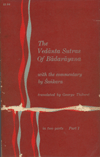
|
124. HINDU: THE VEDANTA SUTRAS OF BADARAYANA - PART I
by Badarayana, George Thibaut (translator)
Publisher: Dover Publications, Inc. (ISBN #: 8120801350, Paperback: 447 Pages , January 1962)
» Submit a review
Summary
The Vedanta Sutras of Badarayana with the Commentary by Sankara translated by George Thibaut.
This two-volume set, originally published in the Sacred Book of the East under the editorship of F. Max Muller, is the definitive translation of the extremely important Vedanta Sutras of Badarayana. First written at an uncertain date before the beginning of the Christian era, they have been accepted by most Indian thought as the consumation of the Upanishads, and their most important interpretation.
|
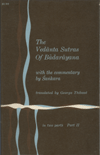
|
125. HINDU: THE VEDANTA SUTRAS OF BADARAYANA - PART II
by Badarayana, George Thibaut (translator)
Publisher: Dover Publications, Inc. (ISBN #: 0486209946, Paperback: 506 pages, January 1962)
» Submit a review
Summary
The Vedanta Sutras of Badarayana with the Commentary by Sankara translated by George Thibaut.
This two-volume set, originally published in the Sacred Book of the East under the editorship of F. Max Muller, is the definitive translation of the extremely important Vedanta Sutras of Badarayana. First written at an uncertain date before the beginning of the Christian era, they have been accepted by most Indian thought as the consumation of the Upanishads, and their most important interpretation.
|
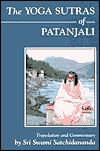
|
126. HINDU: THE YOGA SUTRAS OF PATANJALI
by Patanjali, Sri Swami Satchidananda (translator)
Publisher: Integral Yoga Publications (ISBN #: 0932040381, Paperback: 263 pages , October 1990)
» Submit a review
Summary
Excellent book on the philosophy of yoga, November 26, 2001
Reviewer: Jaishankar Panchapakesan (Richmond, VA)
This is *the* book to refer to get a proper understanding of the philosophy of Yoga. I have gone through other books ( B. K. S. Iyengar , Georg Feuerstein , Swami Prabhavananda) and some audio cassetes on the Yoga Sutras.
This is by far the best book on the subject. The sutras are beautifully explained in layman terms with ample annotations. The sutras in samadhi pada and sadhana pada are covered extensively.
Whenever there was a discrepency in the translation among different authors (such as sutras 18,19,33 of sadhana pada, which have been interpreted very differently) I found the translation and explanation in this book to be most logical, intuitive and complete.
|
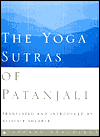
|
127. HINDU: THE YOGA SUTRAS OF PATANJALI
by Alistair Shearer (translator)
Publisher: Bell Tower (ISBN #: 0609609599, Hardcover, 144 pp, January 2002)
» Submit a review
Summary
From the Publisher
"The Yoga Sutras were cast in their present form in India around the third century B.C. Yoga is from the Sanskrit root meaning "union," and a sutra is a thread or aphoristic verse. The basic questions "Who am I?" "Where am I going?" "What is the purpose of life?" are asked by each new generation, and Patanjali's answers form one of the oldest and most vibrant spiritual texts in the world. He explains what yoga is, how it works, and exactly how to purify the mind and let it settle into absolute stillness. This stillness is our own Self. It is the indispensable ground for Enlightenment, which is the ultimate goal of all our aspirations." Alistair Shearer's introduction and translation, fully preserving Patanjali's style, bring these ancient but vital teachings to those who seek the path of self-knowledge today.
|
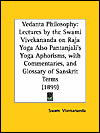
|
128. HINDU: VEDANTA PHILOSOPHY: LECTURES BY THE SWAMI VIVEKANANDA ON RAJA YOGA ALSO PATANJALI'S YOGA APHORISMS, WITH COMMENTARIES, AND GLOSSARY OF SANSKRIT TERMS (1899)
by Swami Vivekananda
Publisher: Kessinger Publishing (ISBN #: 1564597970, Paperback: 400 pages , March 1997)
» Submit a review
Summary
Vedanta Philosophy: Lectures by the Swami Vivekananda on Raja Yoga Also Patanjali's Yoga Aphorisms, with Commentaries, and Glossary of Sanskrit Terms (1899)
|
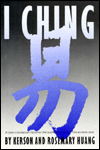
|
129. I CHING
by Kerson Huang & Rosemary Huang
Publisher: Workman Publishing Company (ISBN #: 0894803190, Paperback, 208 pp, January 1986)
» Submit a review
Summary
Editorial Reviews
Book Description
For three thousand years, people have sought personal insight and a window on the future from the I Ching, or the Book of Changes, the classic Chinese oracle and book of wisdom. Drawing on archeological findings, previously published only in Chinese, indicating how the I Ching was actually used by those who created it, and motivated by a lifetime of personal use and fascination, Kerson Huang has created a new translation of great significance.
Restoring the I Ching to its original form, Huang underscores its first use as a practical oracle by Chinese farmers. His translation beautifully preserves the starkly poetic voice of the original, while his comments clearly and simply explain the images and detail the historical references buried within the verse. Huang reveals the I Ching as an epic poem equivalent to The Iliad and The Odyssey--one hexagram recalls the dethroning of Feng Feng; a series of lines portray Wang Hai, one of the three High Ancestors of the Shang dynasty; a third contains a sage proclamation of Lord Tang.
Each hexagram and its corresponding interpretation is presented on a two-page spread, making this version unusually easy to use and understand. Introductory chapters detail the evolution of the I Ching, from the philosophical reinterpretations of Confucius to the modern musings of Carl Jung, and clearly explain both the coin method and yarrow-stalk method for consulting the oracle.
About the Author
Kerson Huang, Ph.D., grew up in Canton, China and is currently a professor of physics at MIT. He and his wife Rosemary have consulted the I Ching regularly and pursued their translation through years of research.
|
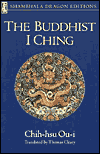
|
130. I CHING: THE BUDDHIST I CHING
by Chih-Hsu Ou-I, Thomas Cleary (translator)
Publisher: Shambala Publications, Inc. (ISBN #: 0877734089, Paperback: 240 pages , July 2001)
» Submit a review
Summary
Buddhist Wisdom for a Changing World, August 11, 2000
Reviewer: Michael P. McGarry (San Francisco, CA United States)
The *I Ching* is the world's oldest divination text. Based on the ancient Chinese philosophy of Yin and Yang, it provides timeless wisdom about how to negotiate the changing nature of events. In seventeenth century China, the Buddhist commentator Chih-hsu Ou-i (1599-1655) wrote a Buddhist version of the *I Ching*; this book is a translation of Chih-hsu's version of the *I Ching*. This version resonates with several streams of thought in China: on the whole, it is deeply ethical in its outlook; at times, it sounds a bit Taoist, and in other places, there are echoes of Zen. Overall, there is a tremendous amount of wisdom in this book, for Chih-shu was well-versed in the esoteric traditions of China. The entire text is a compassionate attempt to guide souls, through the ups and downs of a changing world, to the ultimate goal of enlightenment. The book may be consulted for divination as an ordinary translation of the *I Ching* would be, or it can be read from cover to cover.
|
|
|

SUPPORT ZENGUIDE.COM

Purchase posters, art prints, media (music CD & DVD)
 ZEN GARDEN
ZEN GARDEN
by Chris Simpson
→Puchase this Item
→More Art Prints & Media
→Zen & Buddhism books
|
|
|
s
.
t
.
o
.
r
.
i
.
e
.
s
.
,
.
.
b
.
o
.
o
.
k
.
s
.
.
&
.
.
m
.
e
.
d
.
i
.
a
.
|















 ZEN GARDEN
ZEN GARDEN









